|
Vikidia currently has 4,624 articles. Improve it! |
|
Join Vikidia: create your account now and improve it! |
Oxygen
Oxygen (chemical symbol O and atomic number 8) is a chemical element. It is a gas at room temperature. Oxygen is very important for life on earth. The atmosphere of the earth consists of approximately 21% oxygen. Oxygen is a gas with no color or smell. Humans and animals must breathe oxygen in order to live, and plants give off oxygen. Water (H2O) is a well-known chemical compound, which consists of one oxygen atom. Combustion, or burning, is caused by the reaction of oxygen and another element or compound.
Discovery of oxygen[edit | edit source]
Oxygen was initially discovered in 1772 by Carl Wilhelm Scheele. Then Joseph Priestley also discovered it two years later and spread the news before Scheele. This made many people think that Priestley discovered oxygen first. The word oxygen comes from Greek words: oxus (acid) and gennan (generate). Oxygen comes to earth from all parts of the universe in meteorites. It is also found in minerals and plants that grow on the earth and other planets.
Oxygen in nature[edit | edit source]
Water contains oxygen. When one oxygen atom combines with two hydrogen atoms, they form a molecule of water (also written as H2O). This water is required by all living things to live.
Air also contains oxygen. Air is made of many gases that are mixed together. Approximately 21% of the air is oxygen. Oxygen is especially important because all animals use oxygen to get energy from their food.
Sources[edit | edit source]
- The newest version of this article on Vikidia has included some of the material found in the article Oxygen on the Simple English Wikipedia.


